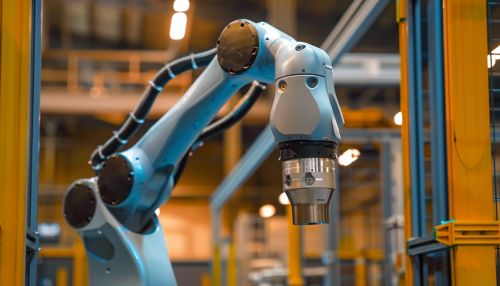Collaborative robots
Introduction
Collaborative robots, also known as cobots, are a type of industrial robot designed to work alongside human workers in a shared workspace. Unlike traditional industrial robots, which are often isolated from human workers for safety reasons, cobots are built with safety features that allow them to interact directly with human workers. This allows for a more flexible and efficient workflow, as cobots can assist in tasks that are difficult, dangerous, or monotonous for human workers.


History and Development
The concept of collaborative robots was first introduced in the 1990s by the General Motors Foundation. The term "cobot" was coined by J. Edward Colgate and Michael Peshkin, professors at Northwestern University, who developed the first cobot prototypes. These early cobots were not autonomous, but rather were controlled by a human operator, providing physical assistance to the operator's movements.
Over the years, advancements in technology have led to the development of more sophisticated cobots. Modern cobots are often equipped with advanced sensors, artificial intelligence, and machine learning capabilities, allowing them to learn from and adapt to their environment. They can also be programmed to perform a wide variety of tasks, from simple pick-and-place operations to complex assembly tasks.
Design and Features
Collaborative robots are designed with a number of features that distinguish them from traditional industrial robots. One of the key features of cobots is their safety mechanisms, which allow them to work in close proximity to humans. These safety features may include force-limited joints, collision detection sensors, and speed and separation monitoring systems.
Cobots are also designed to be easy to program and operate. Many cobots use a graphical user interface for programming, allowing operators with little or no programming experience to easily set up and configure the robot. Some cobots even offer "teach" modes, where the robot learns a task by physically guiding it through the motions.
Applications
Collaborative robots are used in a wide range of industries, including manufacturing, healthcare, agriculture, and logistics. In manufacturing, cobots are often used for tasks such as assembly, packaging, and quality inspection. In healthcare, cobots can assist in tasks such as patient care, surgery, and rehabilitation. In agriculture, cobots can be used for tasks such as harvesting, sorting, and packing produce. In logistics, cobots can assist in tasks such as sorting, packing, and transporting goods.
Future Trends
The market for collaborative robots is expected to grow significantly in the coming years, driven by factors such as the increasing demand for automation, the need for flexible manufacturing processes, and the growing adoption of Industry 4.0 practices. Future trends in cobot technology may include the development of more advanced sensors and artificial intelligence capabilities, the integration of cobots with other technologies such as augmented reality and the Internet of Things, and the development of new applications for cobots in industries such as construction and hospitality.
